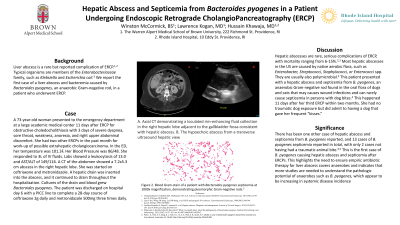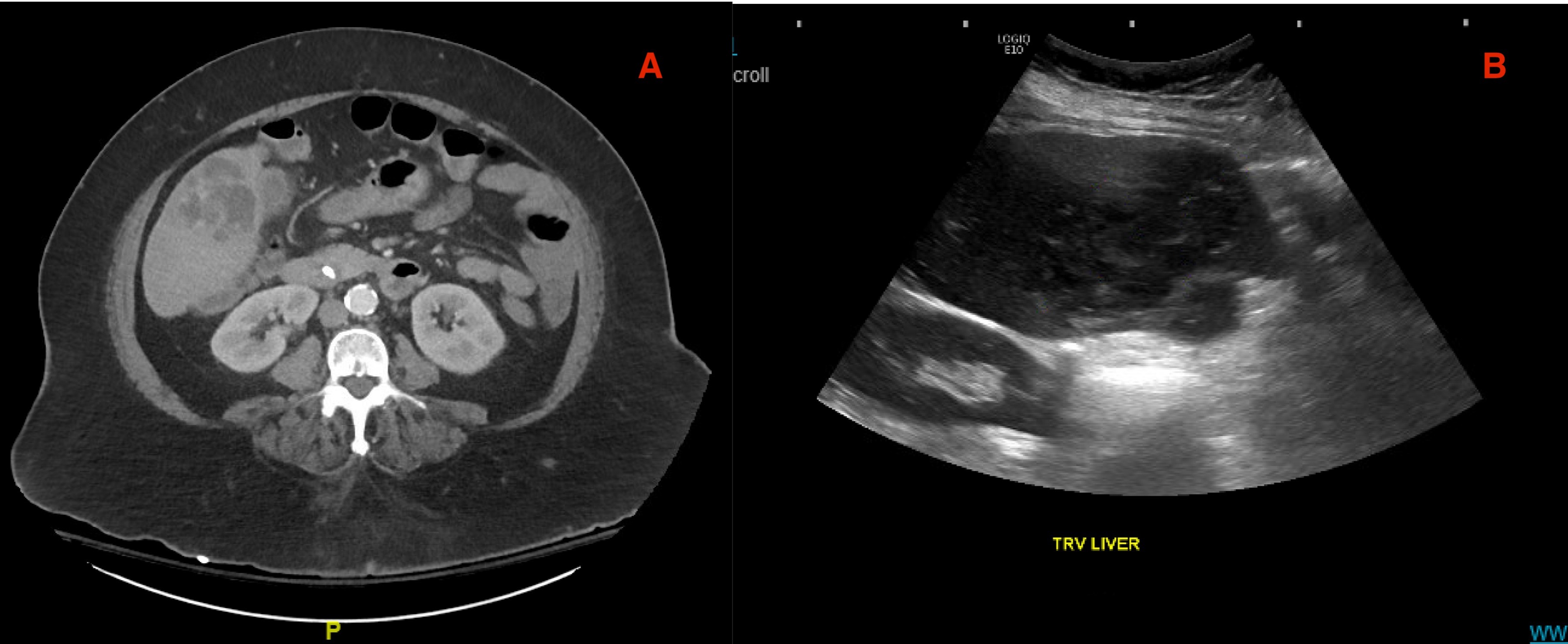Back

Poster Session B - Monday Morning
Category: General Endoscopy
B0302 - Hepatic Abscess and Septicemia From Bacteroides Pyogenes in a Patient Undergoing Endoscopic Retrograde CholangioPancreatography (ERCP)
Monday, October 24, 2022
10:00 AM – 12:00 PM ET
Location: Crown Ballroom

- WM
Winston McCormick, BS
Warren Alpert Medical School of Brown University
Providence, RI
Presenting Author(s)
Winston McCormick, BS1, Lawrence Kogan, MD1, Hussain R. Khawaja, MD2
1Warren Alpert Medical School of Brown University, Providence, RI; 2Alpert Medical School of Brown University/Rhode Island Hospital, Providence, RI
Introduction: Liver abscess is a rare but reported complication of ERCP. Typical organisms are members of the Enterobacteriaceae family, such as Klebsiella and Escherichia coli. We report the first case of a liver abscess and bacteremia caused by Bacteroides pyogenes, an anaerobic Gram-negative rod, in a patient who underwent ERCP.
Case Description/Methods: A 73-year-old woman presented to the emergency department at a large academic medical center 11 days after ERCP for obstructive choledocholithiasis with 3 days of severe dyspnea, sore throat, weakness, anorexia, and right upper abdominal discomfort. She had two other ERCPs in the past month for work-up of possible extrahepatic cholangiocarcinoma. In the ED, her temperature was 101.3F. Her Blood Pressure was 86/48. She responded to 3L of IV fluids. Labs showed a leukocytosis of 13.0 and AST/ALT of 149/116. A CT of the abdomen showed a 7.2x5.3 cm abscess in the right hepatic lobe. She was started on ceftriaxone and metronidazole. A hepatic drain was inserted into the abscess, and it continued to drain throughout the hospitalization. Cultures of the drain and blood grew Bacteroides pyogenes. The patient was discharged on hospital day 6 with a PICC line to complete a 28-day course of ceftriaxone 2g daily and metronidazole 500mg three times daily.
Discussion: Hepatic abscesses are rare, serious complications of ERCP, with mortality ranging from 6-15%. Most hepatic abscesses in the US are caused by native aerobic flora, such as Enterobacter, Streptococci, Staphylococci, or Enterococci spp. This patient presented with a hepatic abscess and septicemia from B. pyogenes, an anaerobic Gram-negative rod found in the oral flora of dogs and cats that may causes wound infections and can rarely cause septicemia in persons with dog bites. This happened 11 days after her third ERCP within two months. She had no traumatic dog exposure but did admit to having a dog that gave her frequent “kisses.” There has been one other case of hepatic abscess and septicemia from B. pyogenes reported, and 13 cases of B. pyogenes septicemia reported in total, with only 2 cases not having had a traumatic animal bite. This is the first case of B. pyogenes causing hepatic abscess and septicemia after ERCPs. This highlights the need to ensure empiric antibiotic therapy for liver abscess covers anaerobes and indicates that more studies are needed to understand the pathologic potential of anaerobes such as B. pyogenes, which appear to be increasing in systemic disease incidence.

Disclosures:
Winston McCormick, BS1, Lawrence Kogan, MD1, Hussain R. Khawaja, MD2. B0302 - Hepatic Abscess and Septicemia From Bacteroides Pyogenes in a Patient Undergoing Endoscopic Retrograde CholangioPancreatography (ERCP), ACG 2022 Annual Scientific Meeting Abstracts. Charlotte, NC: American College of Gastroenterology.
1Warren Alpert Medical School of Brown University, Providence, RI; 2Alpert Medical School of Brown University/Rhode Island Hospital, Providence, RI
Introduction: Liver abscess is a rare but reported complication of ERCP. Typical organisms are members of the Enterobacteriaceae family, such as Klebsiella and Escherichia coli. We report the first case of a liver abscess and bacteremia caused by Bacteroides pyogenes, an anaerobic Gram-negative rod, in a patient who underwent ERCP.
Case Description/Methods: A 73-year-old woman presented to the emergency department at a large academic medical center 11 days after ERCP for obstructive choledocholithiasis with 3 days of severe dyspnea, sore throat, weakness, anorexia, and right upper abdominal discomfort. She had two other ERCPs in the past month for work-up of possible extrahepatic cholangiocarcinoma. In the ED, her temperature was 101.3F. Her Blood Pressure was 86/48. She responded to 3L of IV fluids. Labs showed a leukocytosis of 13.0 and AST/ALT of 149/116. A CT of the abdomen showed a 7.2x5.3 cm abscess in the right hepatic lobe. She was started on ceftriaxone and metronidazole. A hepatic drain was inserted into the abscess, and it continued to drain throughout the hospitalization. Cultures of the drain and blood grew Bacteroides pyogenes. The patient was discharged on hospital day 6 with a PICC line to complete a 28-day course of ceftriaxone 2g daily and metronidazole 500mg three times daily.
Discussion: Hepatic abscesses are rare, serious complications of ERCP, with mortality ranging from 6-15%. Most hepatic abscesses in the US are caused by native aerobic flora, such as Enterobacter, Streptococci, Staphylococci, or Enterococci spp. This patient presented with a hepatic abscess and septicemia from B. pyogenes, an anaerobic Gram-negative rod found in the oral flora of dogs and cats that may causes wound infections and can rarely cause septicemia in persons with dog bites. This happened 11 days after her third ERCP within two months. She had no traumatic dog exposure but did admit to having a dog that gave her frequent “kisses.” There has been one other case of hepatic abscess and septicemia from B. pyogenes reported, and 13 cases of B. pyogenes septicemia reported in total, with only 2 cases not having had a traumatic animal bite. This is the first case of B. pyogenes causing hepatic abscess and septicemia after ERCPs. This highlights the need to ensure empiric antibiotic therapy for liver abscess covers anaerobes and indicates that more studies are needed to understand the pathologic potential of anaerobes such as B. pyogenes, which appear to be increasing in systemic disease incidence.

Figure: A. Axial CT demonstrating a loculated rim-enhancing fluid collection in the right hepatic lobe adjacent to the gallbladder fossa consistent with hepatic abscess. B. The hypoechoic abscess from a transverse hepatic view
Disclosures:
Winston McCormick indicated no relevant financial relationships.
Lawrence Kogan indicated no relevant financial relationships.
Hussain Khawaja indicated no relevant financial relationships.
Winston McCormick, BS1, Lawrence Kogan, MD1, Hussain R. Khawaja, MD2. B0302 - Hepatic Abscess and Septicemia From Bacteroides Pyogenes in a Patient Undergoing Endoscopic Retrograde CholangioPancreatography (ERCP), ACG 2022 Annual Scientific Meeting Abstracts. Charlotte, NC: American College of Gastroenterology.
